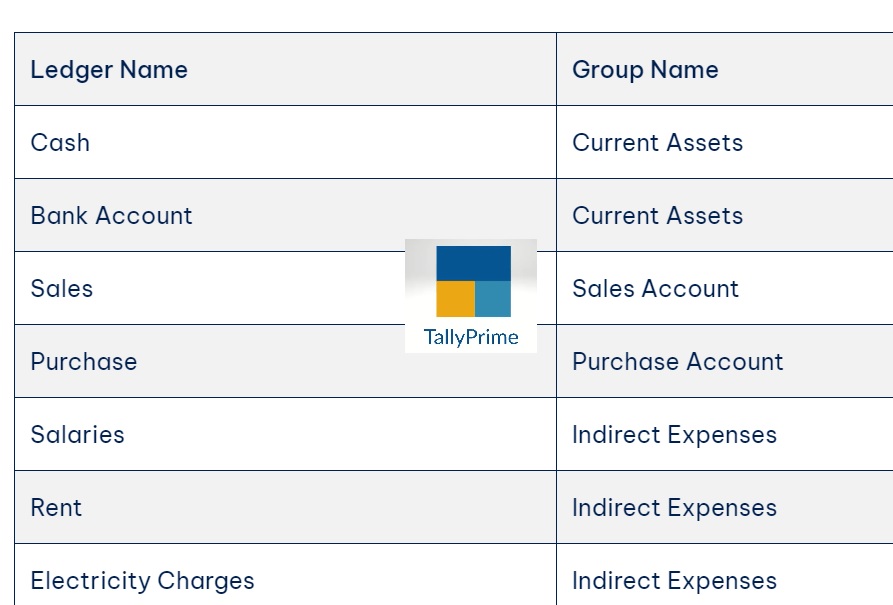Here is a table listing more than 100 commonly used ledgers in Tally Prime along with their respective groups:
| Ledger Name | Group Name |
|---|---|
| Cash | Current Assets |
| Bank Account | Current Assets |
| Sales | Sales Account |
| Purchase | Purchase Account |
| Salaries | Indirect Expenses |
| Rent | Indirect Expenses |
| Electricity Charges | Indirect Expenses |
| Water Charges | Indirect Expenses |
| Telephone Charges | Indirect Expenses |
| Internet Charges | Indirect Expenses |
| Supplier Name | Sundry Creditors |
| Customer Name | Sundry Debtors |
| Accounts Receivable | Sundry Debtors |
| Accounts Payable | Sundry Creditors |
| Capital | Capital Account |
| Loans Taken | Loans (Liability) |
| Building | Fixed Assets |
| Machinery | Fixed Assets |
| Furniture and Fixtures | Fixed Assets |
| Computers | Fixed Assets |
| Inventory | Current Assets |
| Office Supplies | Indirect Expenses |
| Advertising | Indirect Expenses |
| Travel Expenses | Indirect Expenses |
| Legal Fees | Indirect Expenses |
| Audit Fees | Indirect Expenses |
| Insurance | Indirect Expenses |
| Freight Inwards | Direct Expenses |
| Freight Outwards | Indirect Expenses |
| Customs Duty | Direct Expenses |
| Packing Charges | Direct Expenses |
| Sales Returns | Sales Account |
| Purchase Returns | Purchase Account |
| Commission Received | Indirect Income |
| Commission Paid | Indirect Expenses |
| Interest Received | Indirect Income |
| Interest Paid | Indirect Expenses |
| Bad Debts | Indirect Expenses |
| Repairs and Maintenance | Indirect Expenses |
| Depreciation | Indirect Expenses |
| Donations | Indirect Expenses |
| Penalties | Indirect Expenses |
| Miscellaneous Expenses | Miscellaneous Expenses (Asset) |
| Advances to Employees | Loans & Advances (Asset) |
| Loans Given | Loans & Advances (Asset) |
| Investment in Shares | Investments |
| Investment in Bonds | Investments |
| Fixed Deposit | Investments |
| Dividend Received | Indirect Income |
| Dividend Paid | Current Liabilities |
| Drawings | Capital Account |
| Retained Earnings | Reserves & Surplus |
| Provision for Tax | Current Liabilities |
| Income Tax | Current Liabilities |
| GST Payable | Duties & Taxes |
| GST Receivable | Duties & Taxes |
| TDS Payable | Duties & Taxes |
| TDS Receivable | Duties & Taxes |
| Provident Fund | Current Liabilities |
| ESI Payable | Current Liabilities |
| Gratuity Payable | Current Liabilities |
| Loans from Directors | Loans (Liability) |
| Loans from Shareholders | Loans (Liability) |
| Cash Sales | Sales Account |
| Credit Sales | Sales Account |
| Cash Purchases | Purchase Account |
| Credit Purchases | Purchase Account |
| Maintenance Charges | Indirect Expenses |
| Office Rent | Indirect Expenses |
| Factory Rent | Indirect Expenses |
| Professional Fees | Indirect Expenses |
| Consultancy Fees | Indirect Expenses |
| Security Services | Indirect Expenses |
| Outsourcing Charges | Indirect Expenses |
| Training Expenses | Indirect Expenses |
| Recruitment Expenses | Indirect Expenses |
| Subscription Charges | Indirect Expenses |
| Entertainment Expenses | Indirect Expenses |
| Office Cleaning Expenses | Indirect Expenses |
| Stationery | Indirect Expenses |
| Printing Charges | Indirect Expenses |
| Office Repairs | Indirect Expenses |
| Car Expenses | Indirect Expenses |
| Fuel Expenses | Indirect Expenses |
| Vehicle Maintenance | Indirect Expenses |
| Lease Rent | Indirect Expenses |
| Patent Fees | Indirect Expenses |
| Trademark Fees | Indirect Expenses |
| Copyright Fees | Indirect Expenses |
| Subscription Income | Indirect Income |
| Rent Received | Indirect Income |
| Royalty Received | Indirect Income |
| Loan Processing Fees | Indirect Expenses |
| Bank Charges | Indirect Expenses |
| Postage and Courier | Indirect Expenses |
| Freight In | Direct Expenses |
| Freight Out | Indirect Expenses |
| Factory Supplies | Direct Expenses |
| Factory Wages | Direct Expenses |
| Direct Labor | Direct Expenses |
| Indirect Labor | Indirect Expenses |
| Production Overheads | Indirect Expenses |
| Selling Expenses | Indirect Expenses |
| Distribution Expenses | Indirect Expenses |
| Administrative Expenses | Indirect Expenses |
| Marketing Expenses | Indirect Expenses |
| Warranty Expenses | Indirect Expenses |

